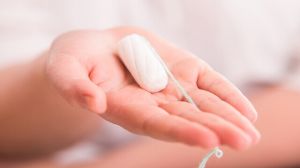
It’s a squeamish topic, but an important one to every woman out there. If you have a uterus, you’ve had a period, and if you’ve had a period, chances are you’ve used a pad or tampon. These convenient products are purchased and used monthly without a second thought because they are so ingrained in our society. A small percentage of women use alternative sanitary options, but the vast majority have never even spared a thought to the potential effects of these common products.
We want to shed some light on the possible dangers of pads and tampons so that you can make an informed decision, before it’s too late. The chronic use of conventional chemical-laden menstrual products may be having unexpected effects on your well-being, including cervical health, fertility and more.
What pads and tampons are made of
Research indicates that the membranes of the vagina and vulva are up to ten times more absorbent than regular skin. Even though sanitary items spend a lot of time in contact with one of the most sensitive and vulnerable areas of the human body, we really have no idea what they are made of. This is because the FDA classes tampons as a “medical device,” so the ingredients do not need to be written on the package or revealed to the public.
However, keen researchers have been able to divulge some of the key “ingredients” that make up pads and tampons.
Chlorine: This is used to bleach the paper and cotton in menstrual products so that they appear clean and white. We all know that chlorine is harmful to human health, but another major concern here are the potential byproducts.
Chlorine can create chemicals called dioxin and trihalomethane in the body. Studies indicate that dioxin can contribute to hormone disruption, abnormal cell and tissue growth and an impaired immune system. In fact the Environmental Protection Agency has determined that there is no safe level of exposure with dioxin, indicating that it is a highly toxic chemical. Dioxin accumulates in fatty tissues and breast milk and is believed to contribute to disorders such as endometriosis.
Pesticides: There are concerns around the pesticides applied to the cotton used to make pads and tampons. It’s also interesting to note that about 94 percent of the cotton in the United States is genetically modified, so there could be absorption of genetically modified organisms through the thin membranes of the vagina.
Plastics and adhesives: Chemicals such as polyester, polyethylene, polypropylene and propylene glycol are used to make pads and tampons. These toxins are associated with concerning effects, such as birth defects and infertility. They may also contribute to the development of cancerous tissues.
Fragrances: Many menstrual products contain artificial scent or odor-blockers, which are known hormone disruptors. They can contribute to fertility problems and other illnesses of the reproductive organs.
Pads and tampons alter your healthy bacteria
Besides the toxins we can absorb from the use of pads and tampons, they also have worrying effects on the body’s microbiome. Recent research has concentrated on the healthy bacteria in the gut, but we are beginning to learn about the importance of those living on or in the skin and mucous membranes as well.
Toxic shock syndrome is a result of one such change, where tampons cause micro-tears in vaginal tissue and create an environment where harmful bacteria thrive. The rare but dangerous syndrome arises from poisons that are produced by staphylococcus or streptococcus bacteria that invade the pelvic area.
All-cotton tampons do not encourage the growth of dangerous bacteria, but most tampons are believed to contain rayon and other synthetics, since these materials are more absorbent.
 Chemical-laden menstrual products may also incite other changes in the vaginal microbiome. These friendly bacteria are very important in defending the pelvic opening against any invading disease-causing organisms.
Chemical-laden menstrual products may also incite other changes in the vaginal microbiome. These friendly bacteria are very important in defending the pelvic opening against any invading disease-causing organisms.
Pads and tampons are bad for the Earth, too
Approximately two billion dollars are spent every year on menstrual products in North America. The average woman will use at least 11,400 tampons in her lifetime.
These tampons are mostly being flushed down the toilet, where all of the chemicals we have discussed end up in our water supply.
Moreover, since pads are made of 90 percent plastic, they add the equivalent of 180 billion additional plastic bags to landfills each year.
Non-toxic alternatives to conventional pads and tampons
We encourage you to try one of the following alternatives to help protect your vaginal, cervical and reproductive health.
- Unbleached organic pads and tampons
- A rubber or silicon washable menstrual cup
- Washable and reusable organic cotton pads
While some of these options require more intimate contact with yourself and your menstrual blood, this should be viewed as a real and liberating experience. We should not be ashamed of menstruation, and hiding it is certainly not worth exposure to carcinogens and toxins.
Celebrate and protect your womanhood by using non-toxic menstrual alternatives. If you experience heavy periods and would like to learn about balancing your hormones to rectify this problem, read more about hormone health here.
—The Alternative Daily
Sources:
http://ehp.niehs.nih.gov/122-a70/
http://www.ncbi.nlm.nih.gov/pmc/articles/PMC3444549/
http://saferchemicals.org/2015/05/12/toxic-tampons-and-pads-tell-always-to-detox-the-box/
http://www.cwhn.ca/en/node/39707
http://www.who.int/mediacentre/factsheets/fs225/en/
http://www.ncbi.nlm.nih.gov/pmc/articles/PMC3238331/?tool=pubmed
http://journals.lww.com/greenjournal/abstract/1980/02000/tampon_associated_vaginal_ulcerations.3.aspx
http://journals.lww.com/greenjournal/Citation/1962/05000/Menstrual_Protection__Advantages_of_the_Menstrual.19.aspx
http://www.nejm.org/doi/pdf/10.1056/NEJM198012183032502
http://www.sciencedirect.com/science/article/pii/0045653594903247
http://toxsci.oxfordjournals.org/content/93/2/223.short
http://cmr.asm.org/content/1/4/432.short

